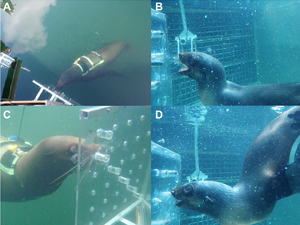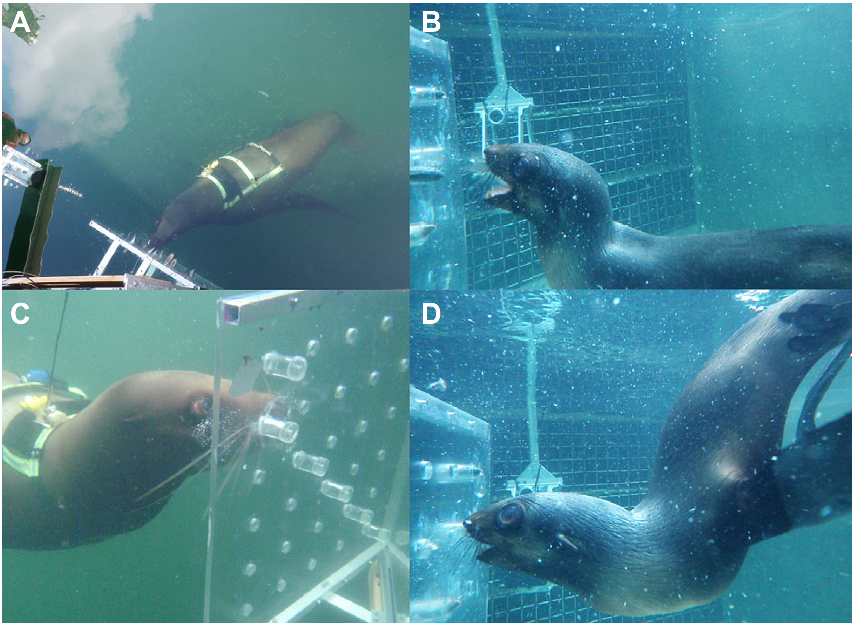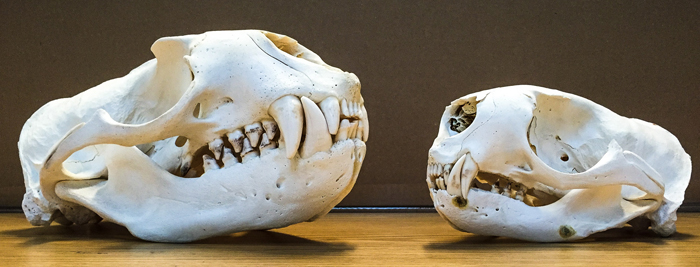
Do feeding strategies drive resilience?
Many thousands of years ago, the ancient ancestors of today’s seals and sea lions moved from their terrestrial homes into the oceans. Over the subsequent epoch, they gradually adapted to their new aquatic environment by altering both their behavior and their physical features. In the process, they developed at least three key strategies to catch fish and other aquatic prey: biting, suction, and jetting water.
These strategies have proven variously effective—some species have survived and thrived to the present day, while others went extinct.
As Consortium scientists uncover the causes of the rapid decline of Steller sea lions and northern fur seals in the North Pacific Ocean over the past 30 years, it is increasingly clear that a root cause is the interactions between these predators and their prey. Could a possible explanation lie in their evolutionary and hunting strategy history?

Steller sea lions with Vancouver Aquarium trainers at the Consortium’s Open Water Research Station.
To better understand the evolution of feeding strategies in Steller sea lions and northern fur seals, Prof. Christopher Marshall (Texas A&M University) undertook an innovative foraging study at the Vancouver Aquarium and the Consortium’s Open Water Research Station. The study was recently published with co-authors Drs. David Rosen and Andrew Trites (UBC) in the Journal of Experimental Biology.
Surprising Result
“We were interested in the techniques these animals use to acquire their prey,” Marshall says. “We looked at Steller sea lions and northern fur seals, and were expecting a similar finding to my previous work with harbor seals—that these animals are all generalists and they’ll use biting when they can, and suction when they can, and hydraulic jetting when they can.”
Marshall explains that bearded seals, belugas, walruses, and to a lesser degree Steller sea lions, can shoot powerful jets of water from their mouth to flush out an animal from a crevice, or pry loose an animal attached to a rock. Scientists call this behavior ‘hydraulic jetting.’ He says suction and hydraulic jetting are particularly useful for bottom feeding around rocky areas.
“There’s some data on wild animals that show they actually do this, and our study has been able to measure and quantify that performance,” he says.
Marshall and colleagues prepared an underwater feeding station by drilling a grid of holes into a large sheet of plexiglass. Behind some of those holes, a recessed plexiglass cylinder imitated a crevasse. The scientists placed fish into each hole and each cylinder, offering animals two choices: they could go for either the food sticking out of a hole, or the food lying in a recessed cylinder.

Seals and sea lions feeding from the experimental apparatus. (A) Top-down view of a Steller sea lion feeding at depth. (B) A northern fur seal displaying wide gape with no lateral gape occlusion. (C) A Steller sea lion using suction and vibrissae. (D) A northern fur seal using vibrissae while using a biting feeding mode.
“They usually went for the fish sticking out of the hole because it was visible,” says Marshall. “They could either bite it or suction it, and we looked at the frequency of suction versus biting. But to access the fish in the recessed cylinder they had to use suction. To our surprise, the northern fur seals didn’t even try to suction, they just nibbled at the edges of the cylinder. We had never come across a marine animal until now that only uses biting. Almost all aquatic animals use some sort of suction, but northern fur seals don’t.”
A Question of Resilience
On the other hand, Marshall characterizes the Steller sea lions—which effectively used both biting and suction—as the ultimate generalists, from a biomechanical perspective.
“The cool thing about Steller sea lions is that they can feed probably anywhere,” he says. “They showed a preference for suction, which is very good for feeding in shallow areas, and for getting fish out from under rocks so they can chase it down and grab it. If they need to take really big prey, we have a good indication that the biting feeding mode is successful for them.”

Steller sea lion skull on left, northern fur seal on right showing the relative differences in dentition and body size.
“This broad feeding repertoire likely mean they’re resilient and adaptable to feeding on many different items,” Marshall says, “and they should be able to adapt to a shift in prey resources.” In contrast, he suspects that northern fur seals specialize on small mesopelagic prey, which rise from the deep scattering layer at night, and they may not fare well in a regime shift or in competition with commercial fisheries.
“People have thought that when mammals returned to the sea, biting was probably the first feeding mode, and suction gradually became a cool way to feed for some species,” Marshall says. “Northern fur seals never got there, which suggests that they’re still exhibiting their ancestral feeding mode, but Steller sea lions did. Because Steller sea lions have the broader feeding repertoire, they can feed on a greater variety of prey, in more diverse habitats.” However, there is a limit to this resiliency if prey abundance is reduced in the North Pacific.
 PUBLICATION
PUBLICATION
|

|

 |
||||||||||||
